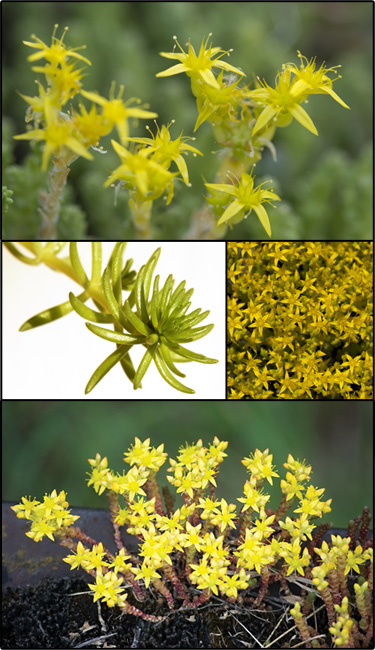Goldmoss stonecrop (Sedum acre)
 Common Names: Mossy stonecrop
Common Names: Mossy stonecropDescription: Introduced to North America as ground cover. Also found in hanging baskets and container gardens.
Habit: Perennial, mat forming, 2-4 in tall forb, succulent, evergreen, stems creeping.
Leaves: Alternate, less than 1/4 in long; broadly oval with a tapering tip; crowded and overlapping; often with dead leaves below.
Stems: Trailing (nonflowering shoots ascending at tip); laxly branched; not bearing rosettes.
Flowers: Hermaphrodite, yellow in color, 5-parted, 1/2 in wide, inflorescence of 2 or more, short, branched clusters (cymes); blooms June through July.
Fruit and seeds: 5 Follicles, spreading, each with a small gland at the base, and tipped by the tapered style.
Habitat: Native to Europe. Found in disturbed areas; rocky, sandy soil.
Reproduction: By seed and vegetatively by rhizomes.
Similar species: Whorled stonecrop or Stringy stonecrop (Sedum sarmentosum).
Monitoring and rapid response: Hand-pulling, making sure to remove all fragments. Credits: The information provided in this factsheet was gathered from the Burke Museum of Natural History and Culture, efloras.org, Robert W. Freckmann Herbarium, and the USDA PLANTS Database.
Individual species images that appear with a number in a black box are courtesy of the Bugwood.org network (http://www.invasive.org).Individual photo author credits may not be included due to the small display size of the images and subsequent difficulty of reading the provided text. All other images appear courtesy of Google (http://images.google.com).
Common Name: | Goldmoss stonecrop |
Scientific Name: | Sedum acre |
Family: | Crassulaceae (Stonecrop) |
Duration: | Perennial |
Habit: | Herbs |
USDA Symbol: | SEAC |
